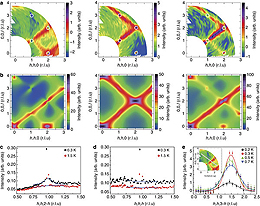Research Abstract
Yb2Ti2O7における磁気クーロン液体から強磁性体へのヒッグス転移
Higgs transition from a magnetic Coulomb liquid to a ferromagnet in Yb2Ti2O7
2012年8月7日 Nature Communications 3 : 992 doi: 10.1038/ncomms1989

スピンアイスと呼ばれるある種のフラストレートした磁性体では、磁気単極子が古典的な欠陥として現れ、磁気のクーロンの法則によって相互作用する。量子力学的相互作用によって、このような磁荷は分割されたボーズ準粒子スピノンによって運ばれ、スピノンはヒッグス機構を介した一次相転移を通してボーズ・アインシュタイン凝縮を起こす可能性がある。今回我々は、単結晶Yb2Ti2O7における磁気クーロン液体から強磁性体へのヒッグス転移を示す証拠を報告する。偏極中性子散乱実験によって、冷却によって発達する[111]ロッド上の散漫散乱とピンチポイントの特徴は、Tc約0.21 K以下になると突然抑制されることが示された。この温度で磁気ブラッグピークと中性子スピンの完全な脱偏極が温度ヒステリシスと共に観測された。これらは強磁性への一次相転移を示している。今回の結果は、量子スピンアイスモデルに基づいて説明され、その高温相は磁気クーロン液体として実質的に記述されるのに対して、基底状態はギャップ型スピン励起を伴うほぼ共線的な強磁性を示す。
- 国立成功大学(台湾)
- 日本原子力研究開発機構 量子ビーム応用研究部門
- 理化学研究所 物性理論研究室
- ユーリッヒ総合研究機構 中性子科学センター(ドイツ)
- 国立台湾大学(台湾)
- National Synchrotron Radiation Research Center(台湾)
- 名古屋大学 理学部物理学科
- 明治大学 理工学部
- ウォーリック大学(英国)
In a class of frustrated magnets known as spin ice, magnetic monopoles emerge as classical defects and interact via the magnetic Coulomb law. With quantum-mechanical interactions, these magnetic charges are carried by fractionalized bosonic quasi-particles, spinons, which can undergo Bose–Einstein condensation through a first-order transition via the Higgs mechanism. Here, we report evidence of a Higgs transition from a magnetic Coulomb liquid to a ferromagnet in single-crystal Yb2Ti2O7. Polarized neutron scattering experiments show that the diffuse [111]-rod scattering and pinch-point features, which develop on cooling are suddenly suppressed below TC~0.21 K, where magnetic Bragg peaks and a full depolarization of the neutron spins are observed with thermal hysteresis, indicating a first-order ferromagnetic transition. Our results are explained on the basis of a quantum spin-ice model, whose high-temperature phase is effectively described as a magnetic Coulomb liquid, whereas the ground state shows a nearly collinear ferromagnetism with gapped spin excitations.

